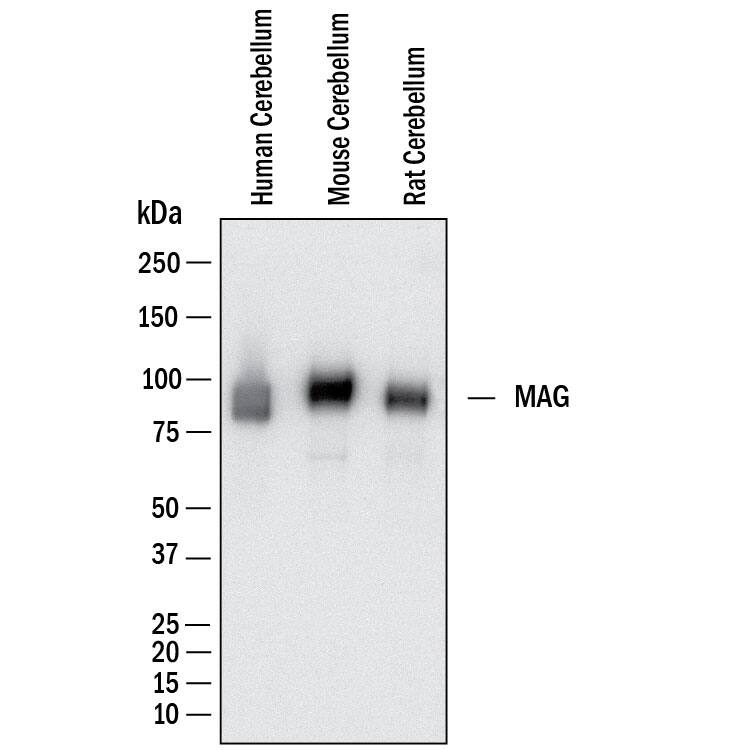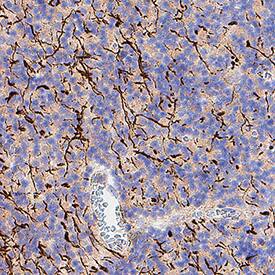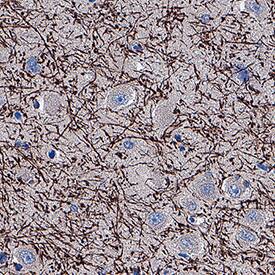Human MAG/Siglec-4a Antibody
R&D Systems, part of Bio-Techne | Catalog # MAB11688


Conjugate
Catalog #
Key Product Details
Species Reactivity
Human
Applications
Immunohistochemistry, Western Blot
Label
Unconjugated
Antibody Source
Monoclonal Mouse IgG2B Clone # 1099521
Product Specifications
Immunogen
Human embryonic kidney cell, HEK293-derived human MAG/Siglec-4a
Gly20-Pro516
Gly20-Pro516
Specificity
Detects recombinant human MAG protein in Direct ELISA.
Clonality
Monoclonal
Host
Mouse
Isotype
IgG2B
Scientific Data Images for Human MAG/Siglec-4a Antibody
Detection of Human, Mouse and Rat MAG/Siglec-4a by Western Blot.
Western Blot shows lysates of human cerebellum, mouse cerebellum and rat cerebellum. PVDF membrane was probed with 1 µg/ml of Mouse Anti-Human MAG/Siglec-4a Monoclonal Antibody (Catalog # MAB11688) followed by HRP-conjugated Anti-Mouse IgG Secondary Antibody (Catalog # HAF018). A specific band was detected for MAG/Siglec-4a at approximately 100 kDa (as indicated). This experiment was conducted under reducing conditions and using Western Blot Buffer Group 1.Detection of MAG/Siglec-4a in Human Cerebellum.
MAG/Siglec-4a was detected in immersion fixed paraffin-embedded sections of human cerebellum using Mouse Anti-Human MAG/Siglec-4a Monoclonal Antibody (Catalog # MAB11688) at 5 µg/ml for 1 hour at room temperature followed by incubation with the Anti-Mouse IgG VisUCyte™ HRP Polymer Antibody (Catalog # VC001) or the HRP-conjugated Anti-Mouse IgG Secondary Antibody (Catalog # HAF007). Before incubation with the primary antibody, tissue was subjected to heat-induced epitope retrieval using VisUCyte Antigen Retrieval Reagent-Basic (Catalog # VCTS021). Tissue was stained using DAB (brown) and counterstained with hematoxylin (blue). Specific staining was localized to the membrane of processes. View our protocol for IHC Staining with VisUCyte HRP Polymer Detection Reagents.Detection of MAG/Siglec-4a in Human Brain Cortex.
MAG/Siglec-4a was detected in immersion fixed paraffin-embedded sections of human brain cortex using Mouse Anti-Human MAG/Siglec-4a Monoclonal Antibody (Catalog # MAB11688) at 5 µg/ml for 1 hour at room temperature followed by incubation with the Anti-Mouse IgG VisUCyte™ HRP Polymer Antibody (Catalog # VC001) or the HRP-conjugated Anti-Mouse IgG Secondary Antibody (Catalog # HAF007). Before incubation with the primary antibody, tissue was subjected to heat-induced epitope retrieval using VisUCyte Antigen Retrieval Reagent-Basic (Catalog # VCTS021). Tissue was stained using DAB (brown) and counterstained with hematoxylin (blue). Specific staining was localized to the membrane of processes. View our protocol for IHC Staining with VisUCyte HRP Polymer Detection Reagents.Applications for Human MAG/Siglec-4a Antibody
Application
Recommended Usage
Immunohistochemistry
3-25 µg/mL
Sample: Immersion fixed paraffin-embedded sections of human Cerebellum and human Brain Cortex
Sample: Immersion fixed paraffin-embedded sections of human Cerebellum and human Brain Cortex
Western Blot
1 µg/mL
Sample: Human cerebellum, mouse cerebellum and rat cerebellum
Sample: Human cerebellum, mouse cerebellum and rat cerebellum
Formulation, Preparation, and Storage
Purification
Protein A or G purified from hybridoma culture supernatant
Reconstitution
Reconstitute lyophilized material at 0.2 mg/ml in sterile PBS. For liquid material, refer to CoA for concentration.
Formulation
Lyophilized from a 0.2 μm filtered solution in PBS with Trehalose.
Shipping
Lyophilized product is shipped at ambient temperature. Liquid small pack size (-SP) is shipped with polar packs. Upon receipt, store immediately at the temperature recommended below.
Stability & Storage
Use a manual defrost freezer and avoid repeated freeze-thaw cycles.
- 12 months from date of receipt, -20 to -70 °C as supplied.
- 1 month, 2 to 8 °C under sterile conditions after reconstitution.
- 6 months, -20 to -70 °C under sterile conditions after reconstitution.
Background: MAG/Siglec-4a
References
- Lopez, P.H. (2014) Adv. Neurobiol. 9:245.
- Salzer, J.L. et al. (1987) J. Cell Biol. 104:957.
- Tang, S. et al. (1997) Mol. Cell. Neurosci. 9:333.
- Schnaar, R.L. and P.H. Lopez (2009) J. Neurosci. Res. 87:3267.
- Schnaar, R.L. (2010) FEBS Lett. 584:1741.
- Akbik, F. et al. (2012) Exp. Neurol. 235:43.
- Lopez, P.H. et al. (2011) J. Neurochem. 116:900.
- Atwal, J.K. et al. (2008) Science 322:967.
- Goh, E.L. et al. (2008) Mol. Brain 1:10.
Long Name
Myelin-associated Glycoprotein
Alternate Names
Siglec-4a, Siglec4a
Gene Symbol
MAG
Additional MAG/Siglec-4a Products
Product Documents for Human MAG/Siglec-4a Antibody
Product Specific Notices for Human MAG/Siglec-4a Antibody
For research use only
